Commentary
Global Warming:
A Critique of the Anthropogenic Model and its Consequences
SUMMARY
According to popular belief, recent global warming has been caused largely by greenhouse gases, primarily CO2, accruing in the atmosphere, and man is responsible for most of the ~120 ppm increase in CO2 over the last 100 years. This article cites a number of recent peer-reviewed scientific papers, and finds that contrary arguments by a growing body of scientists are generally supported by better empirical data than those that favour the ‘anthropogenic warming’ hypothesis. These arguments invoke the effects of solar irradiance and ocean–atmosphere interactions, both of which have been shown to have warming effects at least as great as those claimed for CO2, and to be based on sound, well-understood scientific theory. Furthermore, the global warming models used by the Intergovernmental Panel on Climate Change (IPCC) and others have in some cases been shown to be incorrect and contrary to current temperature statistics. For these and other reasons, the CO2-driven, anthropogenic warming hypothesis is regarded by many as suspect and lacking in empirical evidence. The difficulty of refuting this popular hypothesis is exacerbated by the IPCC’s United Nations mandate to advise governments on the severity of man-made global warming, a mandate that they have followed faithfully, encouraging the emergence of a large body of funded research that supports their view. This presents a problem for global society, as the human-caused warming scenario diverts attention from other, at least equally serious environmental impacts of our industrial society. Recently, however, there appears to be a tilting of public opinion away from global warming alarmism, which may fundamentally affect the direction of the climate change debate.
SOMMAIRE
Selon la croyance populaire, le réchauffement climatique actuel aurait été causé en grande partie par des gaz à effet de serre, principalement le CO2 s’accumulant dans l'atmosphère et, c’est l'homme qui serait à l’origine de l’augmentation de ~ 120 ppm de la teneur en CO2 au cours du dernier siècle. Dans le présent article on cite un certain nombre d’articles scientifiques à comité de lecture, et on conclut que des arguments contraires présentés par un nombre croissant de scientifiques, sont généralement soutenus par de meilleures données empiriques que celles qui favorisent l’hypothèse d’un « réchauffement anthropogénique ». À partir d’une théorie scientifique bien fondée, ces arguments montrent que les effets du rayonnement solaire et des interactions océan-atmosphère ont un effet climatique de réchauffement au moins aussi important que celui imputé au CO2. En outre, il a été démontré que les modèles de réchauffement de la planète utilisés par le Groupe d'experts intergouvernemental sur les changements climatiques (GIEC) et d'autres sont, dans certains cas avérés erronés et en contradiction avec les statistiques actuelles sur la température. Pour ces raisons et d'autres, nombreux sont ceux qui considèrent que l’hypothèse d’un réchauffement climatique anthropogénique par le CO2 est sujette à caution et manque de preuves empiriques. À noter qu’il est d’autant plus difficile de réfuter cette hypothèse populaire que l’Organisation des Nations Unies a confié au GIEC le mandat de conseiller les gouvernements sur la gravité du réchauffement climatique anthropogénique, mandat dont il s’acquitte avec application, ce qui favorise l'émergence d'un important volume de recherches financées, qui tendent à confirmer leur point de vue. Cela pose un problème pour l’humanité entière, en ce que le scénario d’un réchauffement climatique anthropogénique détourne l'attention d’autres problèmes de notre société industriel qui ont des répercussions au moins aussi graves sur l'environnement. Récemment, cependant, il semble y avoir un basculement de l'opinion publique qui tend à remettre en question l'alarmisme ambiant sur le réchauffement climatique planétaire, ce qui pourrait affecter fondamentalement le sens du débat sur le changement climatique.
INTRODUCTION
1 The term ‘global warming’ is commonly used by the media to mean ‘anthropogenic’ global warming; that is, warming caused by human activity. In this article, the writer has chosen to prefix ‘global warming’, where appropriate, by the terms ‘anthropogenic or ‘human-caused’ in order to avoid confusion.
2 We are led today by our media, governments, schools and some scientific authorities to believe that, through his CO2 emissions, man is entirely, or almost entirely, responsible for the modest, modulated rise in global temperature of about 0.7° C that has taken place over the past 100 years. We are told, and many sincere people believe, that if we continue on this path, the planet will experience escalating temperature and dangerous sea-level rise before the end of this century. Over the past 20 years or so, this has become so much a part of our belief system, that to challenge it is to be labelled a ‘denier’ and put in the same category as a member of the Flat Earth Society. Yet, even a cursory review of the peer-reviewed scientific literature will show that the popular anthropogenic global warming dogma is being questioned by hundreds of respected scientists. Furthermore, emerging evidence points directly to other natural phenomena as probably having greater effects on global temperatures than can be attributed to human-caused CO2 emissions. The disproportionate scientific weighting attributed to the anthropogenic warming interpretation, and the general public perception of its validity, could be a serious problem for society, as the human-caused global warming belief is diverting our attention from other, more serious anthropogenic effects such as pollution and depletion of our water resources, contamination of our food and living space from chemicals, and diminishing conventional energy resources.
PROBLEMS WITH THE ANTHROPOGENIC MODEL
3 The fact that the world has undergone cycles of warming and cooling has been known for a very long time, but the question as to man’s influence on climate did not become a hot debate until after the mid-twentieth century, when Revelle and Seuss (1957) first drew attention to the possible effect of greenhouses gases (particularly CO2) on the earth’s temperature. Subsequent studies pointed to the increase in atmospheric CO2 from roughly 0.025% to 0.037%, or 50%, over the past 100 years. Much was made of the apparent but crude covariance of atmospheric CO2 and global temperature, and the conclusion was drawn that man’s escalating carbon emissions are responsible for the late 20th century temperature rise. Anxiety was rapidly raised among environmentalists, and also attracted many scientists who found ready funding for studies aimed at better understanding the problem. However, scientists soon encountered three important difficulties:
- To this date, no satisfactory explanation is forthcoming as to how CO2 at less than 0. 04% of atmospheric concentration can make a major contribution to the greenhouse effect, especially as the relationship between increasing CO2 and increasing temperature is a diminishing logarithmic one (Gerlich and Tscheuschner 2009);
- Geological records show unequivocally that past temperature increases have always preceded, not followed, increases in CO2; i.e. the warming could potentially cause the CO2 increase, but not the reverse. Studies (e.g. Petit et al. 1999) have shown that over the past 400 000 years of cyclical variations, temperature rose from glacial values about 800 years before CO2 concentration increased. A probable explanation is that solar warming, over a long period of time, causes the oceans to outgas CO2, whereas cooling results in more CO2 entering solution, as discussed by Stott et al. (2007). Averaged over a still longer period of geological time, it has been shown (Shaviv and Veizer 2003) that there is no correlation between CO2 and temperature; for example, levels of CO2 were more than twice present day values at 180 Ma, at a time when temperature was several degrees cooler;
- Other serious mistakes in analysis were made by some scientists over the years. Perhaps the worst of these (see Montford 2010 for a thorough discussion) was the publication of the ‘Hockey Stick Curve’ (Fig. 1), a 1000-year record of past temperature which purported to show that "The 20th century is likely the warmest century in the Northern Hemisphere, and the 1990s was the warmest decade, with 1998 as the warmest year in the last 1000 years" (Mann et al. 1999). This conclusion was adopted by the Intergovernmental Panel on Climate Change (IPCC) in its 2001 report and also by Al Gore in the movie An Inconvenient Truth. Subsequently, Mann et al.’s work has been challenged by several scientists (though to be fair, it is also supported by some). For example, McIntyre and McKitrick (2003) amended Mann’s graph, using all available data and better quality control (Fig. 1), and showed that the 20th century is not exceptionally warm when compared with that of the 15th century. However, the IPCC has continued to report a steady increase in global temperature in the face of clear evidence that average temperature has remained roughly level globally, positive in the northern hemisphere and negative in the southern hemisphere, since about 2002 (Archibald 2006; Fig. 2).
WHAT CAUSES WARMING?
4 It is likely that the cyclical warming and cooling of the earth results from a number of different causes, none of which, taken alone, is dominant enough to be entirely responsible. The more important ones are solar changes (including both irradiance and magnetic field effects), atmosphere–ocean interaction (including both multi-decadal climatic oscillations and unforced internal variability), and greenhouse gases. All of these factors have been discussed by IPCC, but the first two have been dismissed as negligible in comparison with the greenhouse-gas effect and man’s contribution to it through anthropogenic CO2. It is claimed (e.g. Revelle and Suess 1957) that the particular infrared absorption bands of CO2 provide it with a special ability to absorb and re-radiate the sun’s longer wavelength radiation, causing warming of the troposphere and an increase in high-altitude (cirrus) cloud, further amplifying the heating process. Detailed arguments against this conclusion can be found in Spencer et al. (2007) and Gerlich and Tscheuschner (2009). These scientists point out (among other arguments, which include the logarithmic decrease in absorptive power of CO2 at increasing concentrations), that clouds have poor ability to emit radiation and that the transfer of heat from the atmosphere to a warmer body (the earth) defies the Second Law of Thermodynamics. They argue that the Plank and Stefan-Boltzman equations used in calculations of radiative heat transfer cannot be applied to gases in the atmosphere because of the highly complex multi-body nature of the problem. Veizer (2005) explains that, to play a significant role, CO2 requires an amplifier, in this case water vapour. He concludes that water vapour plays the dominant role in global warming and that solar effects are the driver, rather than CO2. A comprehensive critique of the greenhouse gas theory is provided by Hutton (2009).
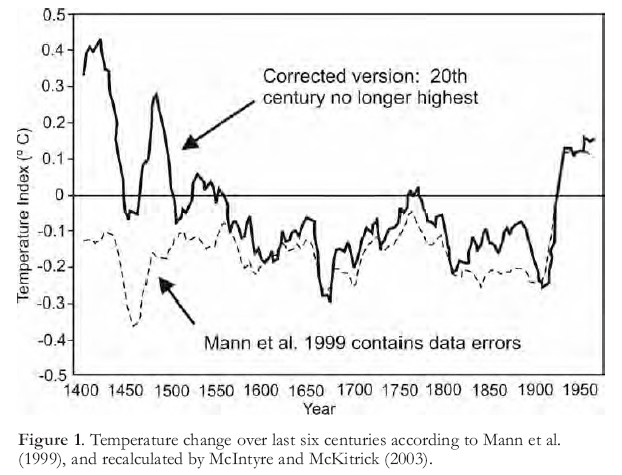 Display large image of Figure 1
Display large image of Figure 1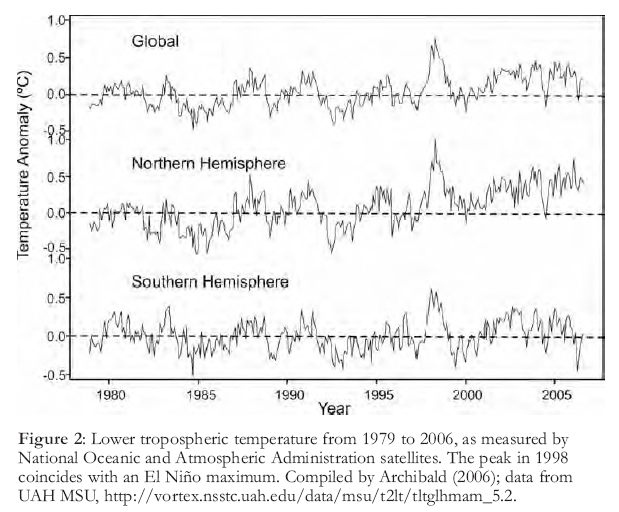 Display large image of Figure 2
Display large image of Figure 25 It is firmly established that the sun is the primary heat source for the global climate system, and that the atmosphere and oceans modify and redirect the sun’s heat. According to Veizer (2005), cosmic rays from outer space cause clouds to form in the troposphere; these clouds shield the earth and provide a cooling effect. Solar radiation, on the other hand, produces a thermal energy flux which, combined with the solar magnetic field, acts as a shield against cosmic rays and thereby leads to global warming. Figures 3 and 4 illustrate both the cooling by cosmic rays (cosmic ray flux, or CRF) and warming by solar irradiation (total solar irradiance, or TSI) in the long term (500 Ma) and short term (50 years), respectively. CRF shows an excellent negative correlation with temperature, apart from a short period around 250 Ma (Fig. 3). In contrast, the reconstructed, oxygen isotope-based temperature curve illustrates a lack of correlation with CO2 except for a period around 350 Ma.
6 Other studies have highlighted the overriding effect of solar radiation on global heating. Soon (2005) studied solar irradiance as a possible agent for medium-term variations in Arctic temperatures over the past 135 years, and found a close correlation in both decadal (5–10 years) and multi-decadal (40–80 years) changes (Fig. 5). As to the control on this variation, the indirect effect of solar irradiance on cloud cover undoubtedly results in modulations of the sun’s direct warming of the earth. Veizer (2005) estimated that the heat reflected by cloud cover is about 78 watts/m2, compared to an insolation effect of 342 watts/m2, a modulation of more than 25%. This contrasts with an IPCC estimate of 1.46 watts/m2, or about 0.5% of TSI, for the radiative effect of anthropogenic CO2 accumulated in the modern industrial era (IPCC 2001). Veizer concludes: "A change of cloud cover of a few percent can therefore have a large impact on the planetary energy balance."
7 In addition to solar insolation effects, the intensity of the Earth’s magnetic field (which deflects the charged particles that constitute cosmic rays) and associated sun-spot maxima are correlated with historic periods of global warming such as the Medieval Climate Optimum (Fig. 6), and typically occur mid-way between ice ages (Veizer 2005). Solar magnetic minima have accompanied global cooling, such as occurred during the Little Ice Age between 1350 and 1850 A.D. A proxy for sunspot activity prior to the start of telescope observations in 1610 can be reconstructed from the abundance of cosmogenic 10Be in ice cores from Antarctica and Greenland (Miletsky et al. 2004).
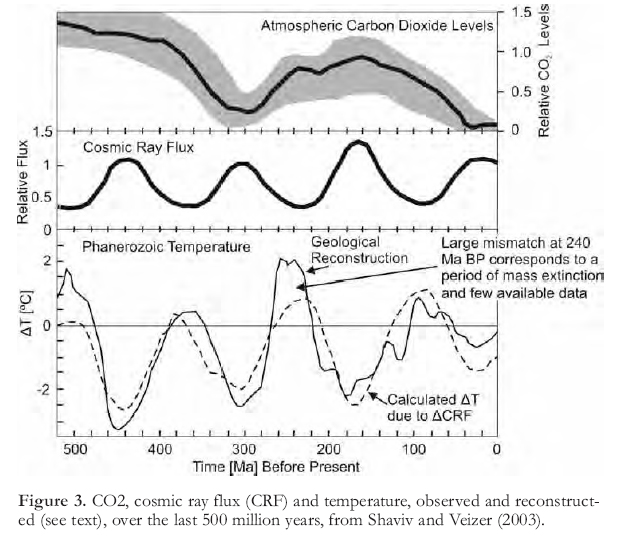 Display large image of Figure 3
Display large image of Figure 3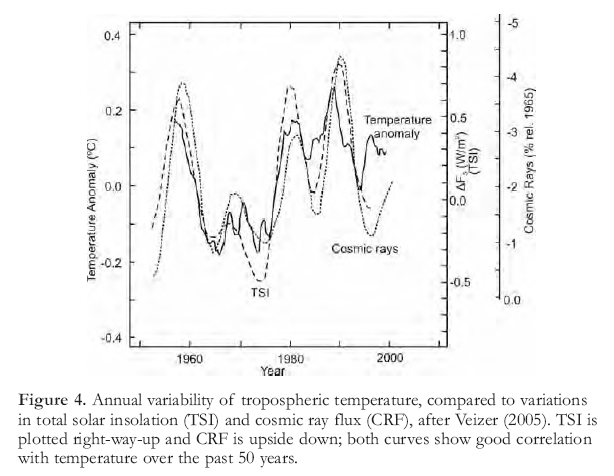 Display large image of Figure 4
Display large image of Figure 48 Global temperature oscillations have been evident in both geologic and recent times, with periods varying from a few years (mostly solar and lunar driven) up to 120 million years (galactic and orbital influences) (Plimer 2009). In addition, ocean– atmosphere interactions are implicated in the control of some shorter-period climatic oscillations. For example, McLean et al. (2009) have studied the El Niño Southern Oscillation (ENSO), a tropical Pacific ocean–atmosphere phenomenon, and compared the index of intensity (the Southern Oscillation Index, or SOI) with global tropospheric temperature anomalies (GTTA) for the 1960–2009 period (Fig. 7). McLean et al. (2009) concluded that "Change in SOI accounts for 72% of the variance in GTTA for the 29-year long record, and 68% for the 50-year record". They found the same or stronger correlation between SOI and mean global temperature, in which SOI accounted for as much as 81% of the variance in the tropics (Fig. 8). A delay of 5 to 7 months was deduced between the SOI maximum and the associated temperature anomaly. Volcanic influences on temperature are also evident (Figs. 7, 8), probably caused by the injection of sulphur dioxide into the stratosphere, where it is converted into sulphate aerosols that reflect incoming solar radiation (McLean et al. 2009). The GTTA nearly always falls in the year or two following major eruptions.
9 Both solar irradiation and ocean–atmosphere oscillations have therefore been demonstrated to have effects on global temperature of at least the same order of magnitude as the CO2 greenhouse gas hypothesis, and these alternative mechanisms are supported by well-documented empirical data. Nevertheless, the CO2 hypothesis, the theoretical basis for which is being increasingly challenged, remains the popular explanation for global warming in the public domain.
THE CONTROVERSY
10 The main factors that have led to heated scientific controversy regarding the cause of the mild late 20th century global warming can be summarized as follows:
- A surge of media coverage and consequent public interest and anxiety, magnified by productions such as Al Gore’s An Inconvenient Truth.
- Fear and concern on the part of environmentalists, who were already aware of many other harmful aspects of industrial, commercial and other human activities. Environmentalists, including NGOs such as Green-peace and the World Wildlife Fund, exploited the open disagreements that existed among scientists as to the scale of the warming and its impacts, disagreements that inevitably arose because climate science is complex and empirical data were in short supply until recently.
- The IPCC was formed in 1988 by two organizations of the United Nations, the World Meteorological Organization and the United Nations Environment Programme, to "assess...the scientific, technical and socio-economic information relevant to understanding the scientific basis of risk of human-induced climate change" (http://www.ipcc.ch/meetings//session21/doc18.pdf). IPCC’s mandate appears to take for granted that man is responsible for at least a significant part of the current global warming. Because of its political nature, the number of subscribing countries (currently 130), and the fact that it carries out no research of its own, defining a scientifically meaningful IPCC consensus has become an almost impossible task. Nevertheless, IPCC has faithfully followed its guidelines in each of its four Assessment Reports, concluding in its fourth report (IPCC 2007) that "Most of the global average warming over the past 50 years is very likely due to anthropogenic GHG increases and it is likely that there is a discernible human-induced warming averaged over each continent (except Antarctica)." (author’s italics). Hidden behind this bold statement are many dissenting opinions by scientists whose views do not appear in the reports. In fact, it is difficult to find in the IPCC lists of authors and reviewers, any prominent independent scientists such as those whose opinions are referred to in this article. This bias has led to serious criticism of the IPCC process. The criticism culminated recently in a study by the Inter-Academy Council (IAC), which recommended, among other changes, that "The IPCC should encourage Review Editors to exercise their authority to ensure that reviewer’s comments are adequately considered by the authors and that genuine controversies are adequately reflected in the report" (Inter-Academy Council 2010). The one-sided nature of the IPCC reports, and the errors that IPCC has since acknowledged, have cast considerable doubt on the validity of the IPCC’s main conclusions. For example, and as mentioned earlier also, claims by IPCC and others that 1998 was the warmest year on record ignore the data from 1500 and earlier, and also fail to point out that 1998 was the year of strongest ocean/atmospheric effect, known as El Niño. Other errors in its climate models, such as the predicted meltdown of the Himalayan glaciers (Guardian, March 10, 2010), and the large number of grey (i.e. not peer-reviewed) literature sources that IPCC cites, have now become widely known in the public domain.
- Politics also plays an important part in the controversy, and a high value is placed on political correctness. The situation is worsened because, very often, a scientific reputation or a career is at stake. Scientists, like most people, are also reluctant to abandon a belief that they have held for a long time, and many scientists have worked in organisations that accepted anthropogenic global warming as a starting point in their research programs. Such persons may have found, and even published, evidence that supports the idea of dangerous human-caused warming. It is doubly hard for such people to convince themselves that there is newer and better evidence that proves the older hypothesis to be wrong. This problem is exemplified by the following quotation from Veizer (2005), in an article in which he presents the case for solar emissions being responsible for much of global warming: "Personally, this last decade has been a trying period due to the years of internal struggle between what I wanted to believe and where the empirical record and its logic were leading me. This article is not a comprehensive review of the alternatives, partly because of space limitations, but also because the case for the alternative has been eloquently argued elsewhere (e.g. IPCC). It is rather a plea for some reflection in our clamour for oversimplified beliefs and solutions in the face of the climate conundrum."Many scientists have been heartened in recent years by the support that has been growing around the world for a new look at the causes of global warming. Articles against anthropogenic causes or offering different explanations appear to this writer to outnumber those in support.
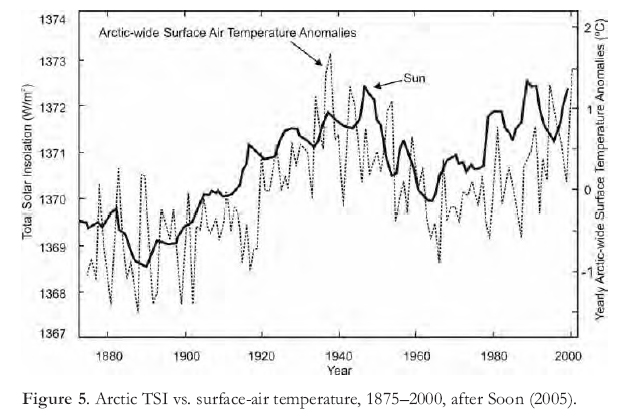 Display large image of Figure 5
Display large image of Figure 5 Display large image of Figure 6
Display large image of Figure 6 Display large image of Figure 7
Display large image of Figure 7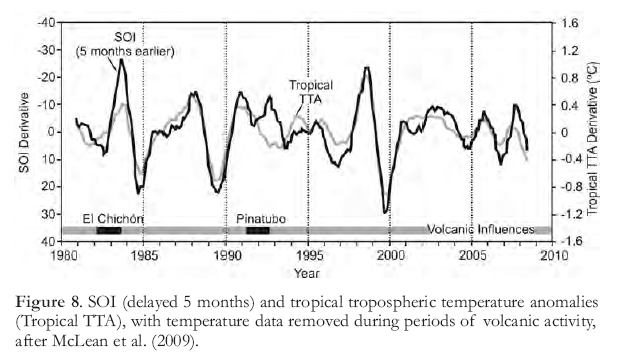 Display large image of Figure 8
Display large image of Figure 8DISCUSSION
11 The following examines various scenarios of climate change policy and other events that may develop over the next 5 to 10 years:
- The pressure of new science, new data, more publications and more frustration with bad policymaking within a large group of mainstream scientists may in due course have the effect of improving policy making on climate change issues, despite the momentum built up by institutions and governments that have currently spent tens of billions of dollars in support of the anthropogenic global warming hypothesis. Such an outcome was already apparent after the 2010 Copenhagen Conference, at which governments had failed to commit themselves to emissions limitation targets that would have seriously damaged their economies. The lack of commitment may perhaps have been fuelled by skepticism as to IPCC’s procedures (see Inter-Academy Council 2010), or precipitated by ‘Climategate’, the reported scandal at the Climate Research Unit (CRU) at the University of East Anglia, which suggested that senior scientific staff were deliberately concealing evidence that cast doubt on anthropogenic warming. (Later, three separate review panels, one a committee of the British parliament and the other two comprising invited senior climate scientists, exonerated CRU of fraud, but the panels were almost unanimous in recommending more openness in IPCC’s investigative and reporting procedures.) Change in public climate policy could be triggered by the increasing number of independently-minded scientists, some in senior government roles, who are making their views regarding the weakness of the anthropogenic warming hypothesis known to politicians and the media. For example, Canada Free Press (2010) cites the case of Dr. Ferenc Miskolczi, a renowned astrophysicist who was dropped as a consultant by NASA for publishing a substantive theoretical criticism of the greenhouse gas hypothesis. Another example is Prof. Harold Lewis’s letter of resignation from the American Physical Society (APS) (Daily Telegraph 2010). In this letter, Professor Lewis condemns the process adopted by APS to paint over objections by members to the society’s public statement on Climate Change, which included the word ‘incontrovertible’ to describe the evidence for dangerous anthropogenic global warming. The likely outcome of a science-driven rethinking of human-caused climate warming is that sufficient doubt will be raised, that new carbon emission treaties and plans for carbon credit trading will be put on hold indefinitely, and established systems discontinued.
- Recently a number of books have been published (e.g. Leroux 2010; Rapp 2010) that question the validity of computer modelling of climate phenomena, including global warming. They point to the fact that climate changes are not the result of "hazard or chaos" (Leroux 2010) but a complex combination of atmospheric, oceanographic and extra-terrestrial events, none of which can be measured accurately enough to support computer-based predictions. Their conclusions cast doubt on whether greenhouse gases have any direct link with global warming and whether, indeed, global temperature is a meaningful parameter considering the vast differences in the climatic conditions of Earth’s geographic and atmospheric regions. An increasing number of scientists consider that the issue is not so much one of hypothetical risks of dangerous human-caused warming, but rather about the known, and often deadly, risks associated with ongoing natural climate events and hazards. They urge the adoption of national climate policies that are based upon the known and particular climate hazards of the necessarily local (not global) geography of each nation state. By their very nature, strategies that can cope with the dangers and vagaries of natural climate change will readily cope with human-caused change also, should it ever become manifest. This approach is discussed in recent books by Carter (2010) and Brunner and Lynch (2010).
- The major danger posed by current policies that are aimed at CO2 reduction is that they divert efforts and funds that might achieve much more urgent and realizable environmental goals. In addition, anti-CO2 measures manifest themselves, in the short term, in costly energy alternatives and CO2 remission or sequestration programs. Energy conservation and market efficiencies will, in the longer run, dictate the use of alternative energy sources such as geothermal. In the meantime, policy makers would be wise to continue regulating the reduction of known harmful emissions of compounds and particulates, and put into place appropriate incentives for both industry and homeowners to reduce real pollution. But this can and should be done without incurring the huge expense involved in the CO2 reduction programs now under consideration.
- Changes in public policy are not taking place in time to prevent some jurisdictions from enacting carbon emissions legislation, e.g. European nations and New Zealand. Elsewhere, some states in the USA and some provinces in Canada are contemplating severe emissions limits, with the intention of punishing offenders by levying a tax that would be credited to companies adhering to their emission limits. Some programs such as ‘Cap and Trade’ (Ontario) and ‘Emission Trading Scheme’ (Australia) appear close to enactment, though recently (May, 2010) the Prime Minister of Australia bowed to pressure from the public and the scientific community and put the Australian program on hold.
- Regarding the path of global temperature in the near future, historical data (e.g. Khandekar et al. 2005) suggest that average global temperature will probably continue to rise and fall, due to natural effects, on a cycle of about 1200– 1500 years and with a departure from mean of about 0.5 deg C. If this is the case, the warming seen in the late 20th century may resume intermittently for up to the next 300 years. In the shorter term, we can perhaps expect a cooling over the next 5–20 years because of a weak Solar Cycle 24 (Archibald 2006) and the generally quiet nature of the sun, although an active El Niño (McLean et al. 2009) and lower cosmic ray activity could both act to counter this. It is also possible that the peak of warming attained near the end of the 20th century will prove to correspond to the apex of the millennial solar cycle, in which case the short-term cooling expected in the next few years will extend thereafter into the next cold phase, equivalent to the Little Ice Age.
FALLOUT
12 Some of the wisest words on the subject of global warming were uttered by Pope Benedict XVI (quoted by Plimer 2009):
13 One positive outcome of the rise and fall of human-caused global warming furor may be the rejection of post-modern science in favour of a revival of the traditional scientific culture which defers strictly to empirical facts and experiments rather than computer models, and encourages the questioning of accepted theory by ‘thinking outside the box’. Nearly all the great scientific breakthroughs and truths in history have been won by the relentless application of empirical methodology in an atmosphere of lateral thinking. Skepticism is an essential element in the search for scientific truth. As explained by Nield (2010): "Those who pay scant attention to history often find themselves denying a revolutionary idea because ‘how can so many people have been so wrong for so long’ "and "The number of people who believe something has no bearing on its rightness".
14 In 1954 the famous Canadian geophysicist J. Tuzo Wilson abandoned his belief that continents formed from volcanic island arcs, in favour of the theory of continental drift, earlier espoused by Alfred Wegener. Wilson’s enthusiasm for the new hypothesis was such that he became known, in some circles, as the Father of Continental Drift; his reputation suffered not at all.
The author acknowledges reviews by Andrew D. Miall and Bob Carter, and some valuable suggestions from Geo-science Canada editor Reginald Wilson.
Norman Paterson is a Professional Engineer and Consulting Geophysicist with 60 years’ experience in Mineral and Environmental Geophysics. He obtained his Ph. D in Geophysics at the University of Toronto in 1955, and was elected Fellow, Royal Society of Canada in 1977. His work has taken him to 43 countries, where he has done pioneering work on groundwater exploration and management, as well as mineral and hydrocarbon exploration. He was inducted into the Canadian Mining Hall of Fame in 2002.